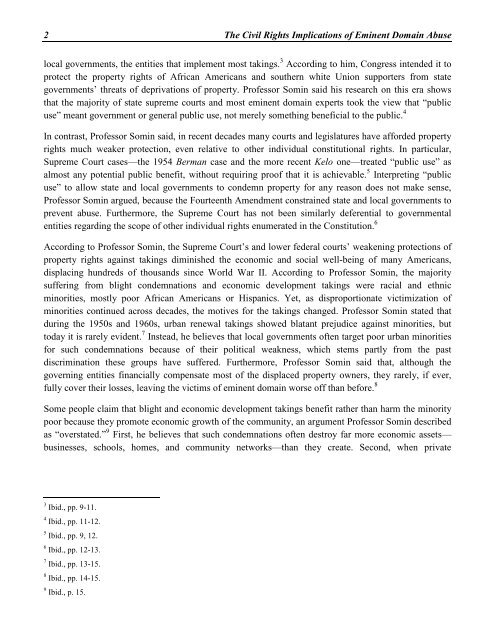Create successful ePaper yourself
Turn your PDF publications into a flip-book with our unique Google optimized e-Paper software.
2 The Civil Rights Implications of <strong>Eminent</strong> <strong>Domain</strong> Abuselocal governments, the entities that implement most takings. 3 According to him, Congress intended it toprotect the property rights of African Americans and southern white Union supporters from stategovernments’ threats of deprivations of property. Professor Somin said his research on this era showsthat the majority of state supreme courts and most eminent domain experts took the view that “publicuse” meant government or general public use, not merely something beneficial to the public. 4In contrast, Professor Somin said, in recent decades many courts and legislatures have afforded propertyrights much weaker protection, even relative to other individual constitutional rights. In particular,Supreme Court cases—the 1954 Berman case and the more recent Kelo one—treated “public use” asalmost any potential public benefit, without requiring proof that it is achievable. 5 Interpreting “publicuse” to allow state and local governments to condemn property for any reason does not make sense,Professor Somin argued, because the Fourteenth Amendment constrained state and local governments toprevent abuse. Furthermore, the Supreme Court has not been similarly deferential to governmentalentities regarding the scope of other individual rights enumerated in the Constitution. 6According to Professor Somin, the Supreme Court’s and lower federal courts’ weakening protections ofproperty rights against takings diminished the economic and social well-being of many Americans,displacing hundreds of thousands since World War II. According to Professor Somin, the majoritysuffering from blight condemnations and economic development takings were racial and ethnicminorities, mostly poor African Americans or Hispanics. Yet, as disproportionate victimization ofminorities continued across decades, the motives for the takings changed. Professor Somin stated thatduring the 1950s and 1960s, urban renewal takings showed blatant prejudice against minorities, buttoday it is rarely evident. 7 Instead, he believes that local governments often target poor urban minoritiesfor such condemnations because of their political weakness, which stems partly from the pastdiscrimination these groups have suffered. Furthermore, Professor Somin said that, although thegoverning entities financially compensate most of the displaced property owners, they rarely, if ever,fully cover their losses, leaving the victims of eminent domain worse off than before. 8Some people claim that blight and economic development takings benefit rather than harm the minoritypoor because they promote economic growth of the community, an argument Professor Somin describedas “overstated.” 9 First, he believes that such condemnations often destroy far more economic assets—businesses, schools, homes, and community networks—than they create. Second, when private3 Ibid., pp. 9-11.4 Ibid., pp. 11-12.5 Ibid., pp. 9, 12.6 Ibid., pp. 12-13.7 Ibid., pp. 13-15.8 Ibid., pp. 14-15.9 Ibid., p. 15.


